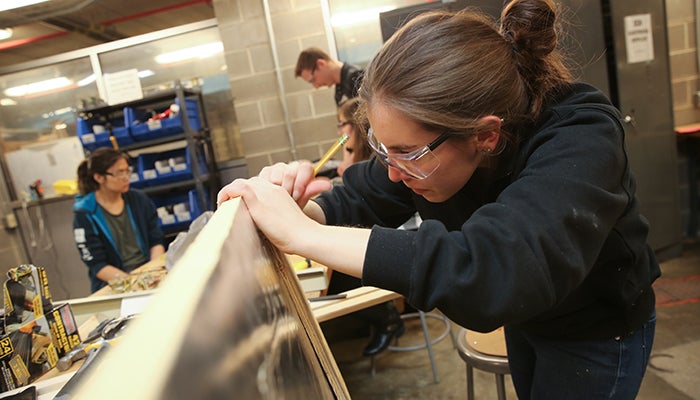A hypertonic grip expander for individuals with cerebral palsy and stroke patients, a chair for autistic students, and an independent lifting device for quadriplegic individuals are the winning designs created by teams of undergraduate students from colleges and universities in the Northeast during the inaugural Engineering Innovation for Society (EIS, pronounced “ice”) student design competition held recently at Rensselaer. The competition was sponsored by the Department of Mechanical, Aerospace, and Nuclear Engineering (MANE) and the School of Engineering.
At Rensselaer, students take on design challenges for industry, service organizations, or entrepreneurs. Working in multidisciplinary teams, and coached by a professor and project engineers with extensive industrial experience, Rensselaer students formulate the problems and conceptualize designs. They work to build prototypes and test their solutions in a fabrication lab with state-of-the-art machining equipment, 3-D printers, and other devices.
Now, with the launch of the annual Engineering Innovation for Society student design competition, undergraduate students from other universities will have an opportunity to visit Rensselaer to experience the engineering workplace of the 21st century—and to help people along the way through their designs. This year’s inaugural competition included 31 students from colleges and universities in the Northeast, including Columbia, George Washington University, Parsons School of Design, MIT, Stevens Institute of Technology, United States Military Academy, University of Buffalo, University of Connecticut, University of Massachusetts-Amherst, University of New Hampshire, Worcester Polytechnic Institute, Yale, and York College of Pennsylvania.
From Jan. 11-14, students were assigned to teams and worked on various design projects for individuals who have disabilities, provided by the Center for Disability Services (CDS) of Albany, N.Y.
“We have long been recognized as a leader in design, producing the very best engineers for the current workplace,” said John Tichy, tribology expert and professor in the Department of Mechanical, Aerospace, and Nuclear Engineering at Rensselaer. “Now we’re expanding our influence, in keeping with The New Polytechnic, to project ‘soft power’ in design, enabling cross-fertilization in new disciplines and with the very best collaborating institutions. Based on our reputation, the undergraduate students from some of the very best schools in the Northeast region came to Rensselaer. We learned from them, they learned from us; and we all made contributions to aid the disabled.”
Tichy noted that he hopes the EIS student design competition and some of its key concepts that are focused on projects driven to help society will spread in future years by reputation and word of mouth. “Using a rapid design paradigm that has been seen in hackathons and makeathons, our primary goal in creating EIS is to bring inventive students to the Rensselaer campus, to introduce them to all aspects of design and prototyping, while also creating a space for them use our facilities, and work with our faculty and staff in the School of Engineering, to develop engineering solutions to real-world practical problems.”
CDS provides services to more than 12,000 infants, children, adolescents, adults and seniors with disabilities, and their families from upstate New York and 26 additional states. The center provides expert care for individuals with over 300 different disability diagnoses, including cerebral palsy, intellectual disabilities, multiple sclerosis, autism spectrum disorders, epilepsy, spina bifida, and traumatic brain injury.
Student projects—which were mechanical in nature—were evaluated both on conceptual design and prototyping. Prizes awarded included $10,000 to the winning team, $4,000 to the second-place team, and $2,000 to the third-place team.
The winning team designs for the EIS 2018 competition are:
First Place: Students created a created a hand splint that can change size and shape. The device is beneficial to individuals who are hypertonic, as it can be difficult and painful to stretch their hand and wrist and position it appropriately. Team members included: Michael Eaton (Worcester Polytechnic Institute), Richard Huizar (MIT), Travis Jones (York College of Pennsylvania), Andrew Reardon (Yale), and Avi Steinburg (Columbia).
Second Place: Students created the autism chair for students to accommodate increased sensory stimulation and vigorous movement. The goal was to propose an affordable design for a classroom setting that would be similar to existing chairs used in the classroom and not stand out. Team members included: Yonah Elorza (Columbia University), Sankee Maringanti (Stevens Institute of Technology), Konstantin Mitic (George Washington University), Noah Payeur (University of New Hampshire), and Gregory Zogby (United States Military Academy).
Third Place: Students worked to develop a convertible wheelchair bed to enable the transition of a quadriplegic individual from the bed to a chair without aid from another person. Team members included: Danielle Browning (University of Connecticut), Oliva Gustafson (University of Buffalo), Kalen Patrick Kahn (United States Military Academy), and Connie Zhang (Columbia University).
Additional teams included:
The Canopy team worked to create a system that could be usable by one person to protect a wheelchair patient from weather-related elements during transfer from a vehicle. Team members included: Aydin Akyol (Yale University), Bettina Arkhurst (MIT), Audrey Balaska (University of New Hampshire), Amanda Redhouse (York College of Pennsylvania), and Jacob Thompson (United States Military Academy).
The Parkinson’s Writing Assistant team worked to create a writing device or pen for individuals suffering from Parkinson’s. Team members included: Christopher Krause (MIT), Valeria Villanueva (Yale), Hannah White (United States Military Academy) and Mey Young Olivares Tay (Stevens Institute of Technology).
The Dental Chair team worked to develop a dental stability device to make the patient more comfortable during visits. According to the CDS, the center has something to assist with keeping a patient’s mouth open during procedures, but the head is held manually, which is inefficient and upsetting to patients. Teams members included: David Cardoza (Worcester Polytechnic Institute), Tyler Langbein (University of Buffalo), Minxuan Li (Parsons School of Design), and Mahdiar Edraki (University of Massachusetts-Amherst)
The Feeding Tube team worked on a prototype to improve the device to address problems with clogging, leaking, detaching, and cleanliness. Team members included: Kelly Ehrhart (Stevens Institute of Technology), Julia Lin (University of Pennsylvania), Eli Mattingly (University of Massachusetts – Amherst), and Brian Savidge (United States Military Academy).


